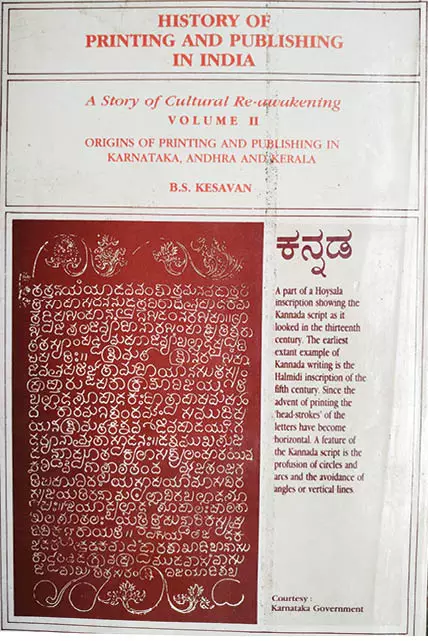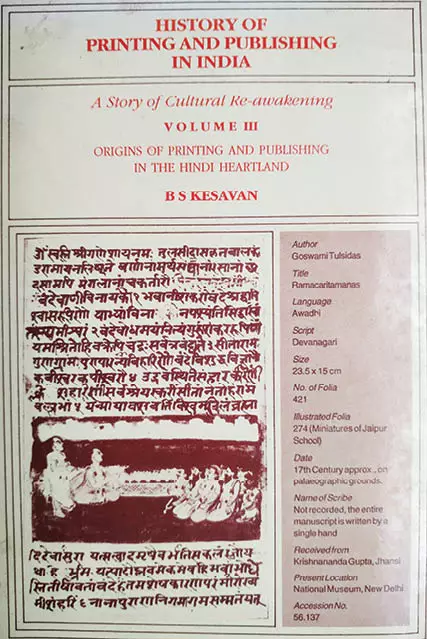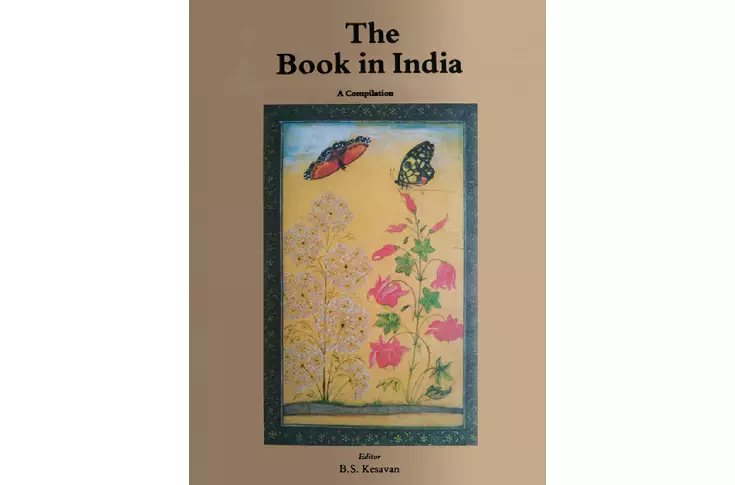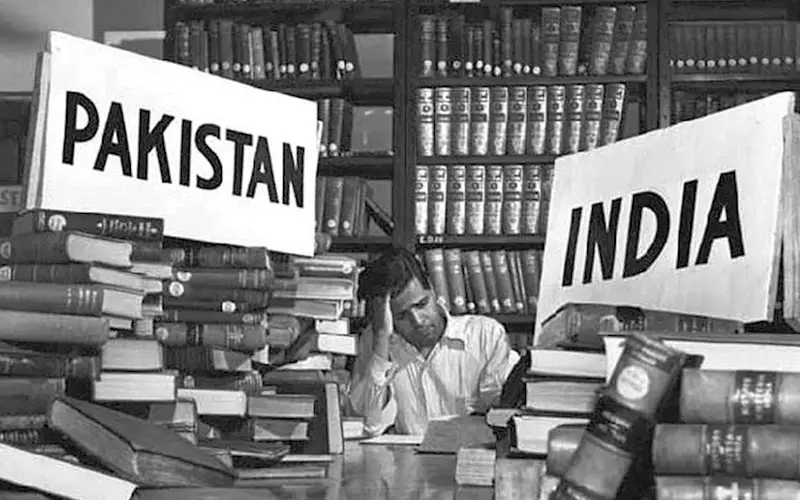Print History: B S Kesavan- Librarian as Print Historian
How a librarian from pre-independence India recast himself as print historian
16 Oct 2020 | By Murali Ranganathan
The year is 1947. The British Empire is in retreat. The new Viceroy of India, Lord Mountbatten, is keen on an early exit from what used to be the Jewel in the Crown. The international news media has arrived to cover the frenzy surrounding this historic event. The partition of the country into two seems inevitable. National borders are being negotiated in grand rooms and penciled onto maps. Along with the geographical partition, the assets of the country were also to be distributed between the two newly independent countries of India and Pakistan. How was this to be done?
The futility of the partition was best captured by a photograph in which a hassled librarian is trying his best to distribute the books in his library between the two countries. This middle-aged librarian was none other than Bellary Shamanna Kesavan and the library was the Imperial Secretariat Library at Delhi. As it happens, the library was not actually split up and the photograph seems to have been staged. When this photograph, taken by D D Duncan, appeared in the August 1947 issue of the American magazine Life, it was Kesavan’s first brush with momentary fame.
The Live-Wire
Born in 1909, B S Kesavan grew up in Mysore. After graduating from the Maharajah’s College in 1927, Kesavan went to London for further studies. Over a period of seven years, he obtained a Master’s degree in English literature besides a diploma in library science.
Returning to India in 1936, he taught English at his alma mater for a few years. Kesavan had a dynamic personality, presence of mind, and was apparently a very popular lecturer among his students. He got the nickname ‘Live-Wire’ because he once saved the life of a passer-by from electrocution by his prompt action. The opportunities at Mysore, then a small town, proved too little for a man of Kesavan’s abilities and ambitions. He moved to Delhi in 1944 where he joined government service.
A librarian for the nation
A newly independent country needed new institutions which would define the new India, and a cadre of dedicated officers who would nurture them. One such institute was the Imperial Library of India at Calcutta which had been established in 1903 by the Viceroy, Lord Curzon by cobbling together the crumbling collections of a few older Calcutta libraries. When the erstwhile librarian of the Imperial Library migrated to Pakistan, B S Kesavan was appointed in his stead in early 1948. Though, according to a friend, he had been warned that “the Library was in the most chaotic condition and only a Hercules could clean the Aegean stables there,” Kesavan enthusiastically took up the role and relocated from Delhi to Calcutta.
Within a period of five years, Kesavan seems to have rebuilt the library anew. By 1953, it had been renamed the National Library of India, had been declared the copyright library for India and received one copy of every Indian publication, and had been rehoused in a grand edifice which had once been the residence of the Lieutenant-Governors of Bengal. Turning a technicality to his advantage, he also managed to prevent the bifurcation of its collections between India and Pakistan. The library was reorganised and separate sections were established for each major Indian language. Kesavan also set in motion a publication programme at the National Library and himself wrote a history of the institution (published 1961). In recognition of his work, Kesavan was awarded the Padma Shri by the Government of India in 1960.

A season for bibliographies
It was at the National Library that Kesavan first began to conceive bibliographical projects on a national scale. The imprints produced by the new nation not only had to be catalogued but also be compiled into bibliographies to present the larger picture. The journal Indian National Bibliography was to be the medium for this venture. It began publication in 1958 and aimed to record all the publications received by the National Library under the Copyright Act.
In 1954, the Government of India constituted the Sahitya Akademi as a national body of letters. Its remit included nurturing the literature of all the official languages of India and every project it undertook had to have a pan-Indian footprint. It was headed by Krishna Kripalani (1907–1992), freedom fighter, author and an entrenched establishment figure.
One of the pan-India projects which Kripalani initiated was a bibliography of Indian literature in the twentieth century. It was to be a selective bibliography of publications in major Indian languages and was to include books “of literary merit, and important and significant books on Philosophy, Religion, History and the other aspects of the Humanities, written with originality, imagination and literary taste.” As the Sahitya Akademi was founded in 1954, the cut-off date was taken as 1953 which was also the year the National Library became the copyright library. The bibliography for each language was to be compiled by an expert on that language while the project was to be directed by a general editor who would formulate the principle for the compilation of the bibliography. Kesavan, as the leading authority on the subject in India, was chosen as the editor of the series.
Working with perhaps the best scholars in each language, Kesavan was able to produce the envisaged four volumes of the bibliography between 1962 and 1974. They were published under the title, The National Bibliography of Indian literature, 1901-1953. A fifth volume devoted to languages which were considered minor earlier appeared much later in 1990. These volumes, produced in a professional manner, continue to remain a valuable resource for researchers and scholars who are interested in the history of print in India in the first half of the twentieth century.
History of Printing and Publishing in India
“An Exercise in Academic Parasitology”
The idea of a pan-India project, which had had its heyday in the 1960s, persisted in some quarters well into the 1980s. Krishna Kripalani, who had been the Secretary of the Sahitya Akademi earlier, was then the Chairman of the National Book Trust. He envisaged a project to write the history of printing and publishing in India. The only person who he could think of for handling the project was B S Kesavan. He had known Kesavan from the 1950s and “admired his organising ability, his wide scholarship and talent as writer and compiler.” Kesavan, though in his seventies, was quite keen to take the project as a challenge, even though he claimed no knowledge of print history. The history was to encompass all the official languages of India and the book was to be published in multiple volumes.
Kesavan was hardly a lone solider. He could call on a veritable army of manpower and resources. Besides the National Book Trust, he was backed by the other government-funded organizations such as Indian Council of Social Science Research. Along with the National Library, all the major archives and libraries of Indian print, both in India and abroad, were freely accessible to him. Unlike most historians and scholars, Kesavan could call upon the services of a phalanx of translators, indexers, typists, proof-readers and editors. Besides being able to refer to their publications, he could also directly consult a wide array of scholars and researchers of print history. Kesavan is very assiduous in acknowledging all the help he has received both at the start of each volume and also throughout the text.
The first volume of the History of Printing and Publishing in India: A Story of Cultural Re-awakening appeared in 1984. But in spite of all the official support he received, it was not all smooth sailing as Kesavan recalls in a letter to an associate in July 1984.
The NBT has at last released to the public the First volume on the History of Printing and Publishing in India, sub-titled, “The Story of Cultural re-awakening”, and further particularised as “South Indian Origins of early printing.” The so-called official release of a few botched-up volumes without index and teeming with printers devils was withdrawn and the whole book reprinted, the badly processed photographs were re-done, and the jacket was redesigned.
Even this reprint seems to have been withdrawn from the market and ultimately the first volume of the series which was published in 1985 seems to have included the text of two volumes. It was sub-titled ‘South Indian Origins of Printing and its Efflorescence in Bengal’. A second volume soon followed in 1988 (Origins of Printing and Publishing in Karnataka, Andhra and Kerala). The third volume dealing with Hindi/Urdu (Origins of Printing and Publishing in the Hindi Heartland) was published in 1997 when Kesavan was nearly ninety years old. No further volumes in the series have appeared to date.


In the introduction to the book, Kesavan himself summarises his approach in a single phrase: “An Exercise in Academic Parasitology.” Neither did Kesavan have the luxury of time to make an independent study of the subject nor did he have the inclination. Much of the three volumes is made up of articles, brochures, extracts from books, translations from non-English languages, lengthy bibliographies, and indexes which are reproduced verbatim from their original sources. Kesavan strings together these extracts without much critical discrimination; the text is very uneven in terms of language, expertise, and reliability.
Perhaps the project was too ambitious in its scope; perhaps it was before its time. Graham Shaw, print historian of South Asia, notes that “although undertaken for the best of motives, it was premature and an individual effort, and simply regurgitated and reflected the existing body of knowledge without advancing our understanding through any great amount of serious original research on his part.” Shaw notes that the attempt to write a comprehensive print history of India, though laudable, was inevitably flawed “because of the lack of fundamental research undertaken by then [the 1980s] to establish the essential facts of the history of print in South Asia – who, what, where, why, how, etc.”
The three volumes that have been published can best be characterised as a survey of source material published before the 1990s for writing a history of printing in India. Though three decades and more have elapsed since the publication of these volumes, print and book historians, working on a single language, or on specific regions and cities, or on individual presses, continue to discover new facts and rewrite print history. A comprehensive history of printing and publishing in India is still a few decades away and can conceivably be written only by a large team of scholars.
The Book in India
Kesavan’s involvement with book and print history in the 1980s led to yet another project related to the history of the book in India before the advent of print. The methodology for this book was no different from the one Kesavan had followed earlier. Focusing mainly on book culture before the era of printing, Kesavan relied exclusively on research conducted by scholars in the previous hundred years to compile the book. Tracing the history of writing in India and the evolution of scripts from the Indus Valley Civilisation to the nineteenth century, Kesavan attempts a broad survey of the evolution of the book.
He also tries to trace the history of writing mediums in the country and its evolution from birch bark (bhurja patra), palm leaves (tada patra), and paper (kagad), besides clay, stone and metal. Limited in its presentation as a preliminary volume, the book serves as a brief introduction to the subject. The compilation contains long extracts from the original sources (that are always credited) which are strung together to form the text, considerably reducing the readability of the text.
First published in 1986 under the title The Book in India: A Compilation, it was again published as a gift souvenir by the National Book Trust to be distributed to visitors at the Frankfurt Book Fair. A second edition with additional illustrations from Mughal-era manuscripts was published in 1992.

The Man and his legacy
In 1963, Kesavan was transferred as the Director of the Indian National Scientific Documentation Centre. After his retirement in 1969, Kesavan spent the 1970s and the 1980s as a member of innumerable government committees on documentation, bibliography, and information management. He regularly submitted reports on the reorganisation of libraries of various state institutions and was also a visiting professor of library science. However, Kesavan seems to have been unsuccessful in breaking through a glass ceiling and leadership positions in national organisations eluded him. In 1970, he was parachuted back as the head of the National Library but left after a year. After his departure, the Library did not have any leadership for nearly a decade, perhaps symptomatic of a malaise which began to infect state institutions from the seventies.
Though rather advanced in years and in failing health, Kesavan retained the ebullience which earned him the moniker of ‘Live-Wire’. Graham Shaw, then with the British Library, recalls meeting him in London in the 1980s: “He still cut a very formidable figure: the sheer physical presence, enormous energy and drive with which he had built up [the National Library] after Independence were still very much apparent. I was full of admiration and awe for that achievement.” The historian Ramachandra Guha, in his essay The Rise and Fall of the Bilingual Intellectual (Economic and Political Weekly, 23rd January 2010), recalled Kesavan’s language skills.
B.S. Kesavan was formidably multilingual. He was fluent in Tamil, Kannada, and English, spoke Bengali adequately and Hindi passably, and had a good grasp of Sanskrit. No doubt his multilingualism came in handy in his work as the first Indian Director of the National Library, his nurturing of a national information system, and his pioneering histories of publishing and printing.
The contributions made by B S Kesavan to the fields of library and information science are indeed very important. At a time when there were not many precedents, Kesavan broke new ground in building organisations for a young nation. The print history projects with which he was involved had the potential to produce landmark publications. However Kesavan’s approach to research and writing rendered the books cumbrous and limited their usefulness. Nevertheless, they will continue to serve as introductory handbooks to the student of Indian print history.
B S Kesavan Chronology
1909: Born in Mylapore, Chennai to S B Iyengar and Shallamma
1929: B Sc , Maharajah’s College, Mysore
1936: M A (English Literature), Birkbeck College, University of London
1936: Diploma in Library Science, London School of Librarianship, University of London
1937: Lecturer in English at Mysore University
1944: Assistant secretary (Editorial), Council of Scientific and Industrial Research
1946: Educationofficer, Government of India & Curator, Library of the Central Bureau of Education
1948: Librarian, Imperial Library of India (later National Library of India)
1953: Elected president of the Indian Library Association
1960: Awarded Padma Shri by Government of India
1962–74: Edited four volumes of The National Bibliography of Indian literature, 1901-1953
1963: Director, Indian National Scientific Documentation Centre
1969: Retirement from government service
1982: Commenced work on History of Printing and Publishing in India
1985-97: Publication of three volumes of History of Printing and Publishing in India
1986: First edition of The Book in India
1992: Second edition of The Book in India
2000: Death in Delhi
2005: Publication of biography by P. T. Nair titled B S Kesavan: First National Librarian of India
2009: Centenary celebration organised by Karanataka State Library Association and Department of Library & Information Science, University of Mysore
2009: Publication of Remembering B. S. Kesavan: the Man and his Mission (edited by L J Havaru)











 See All
See All